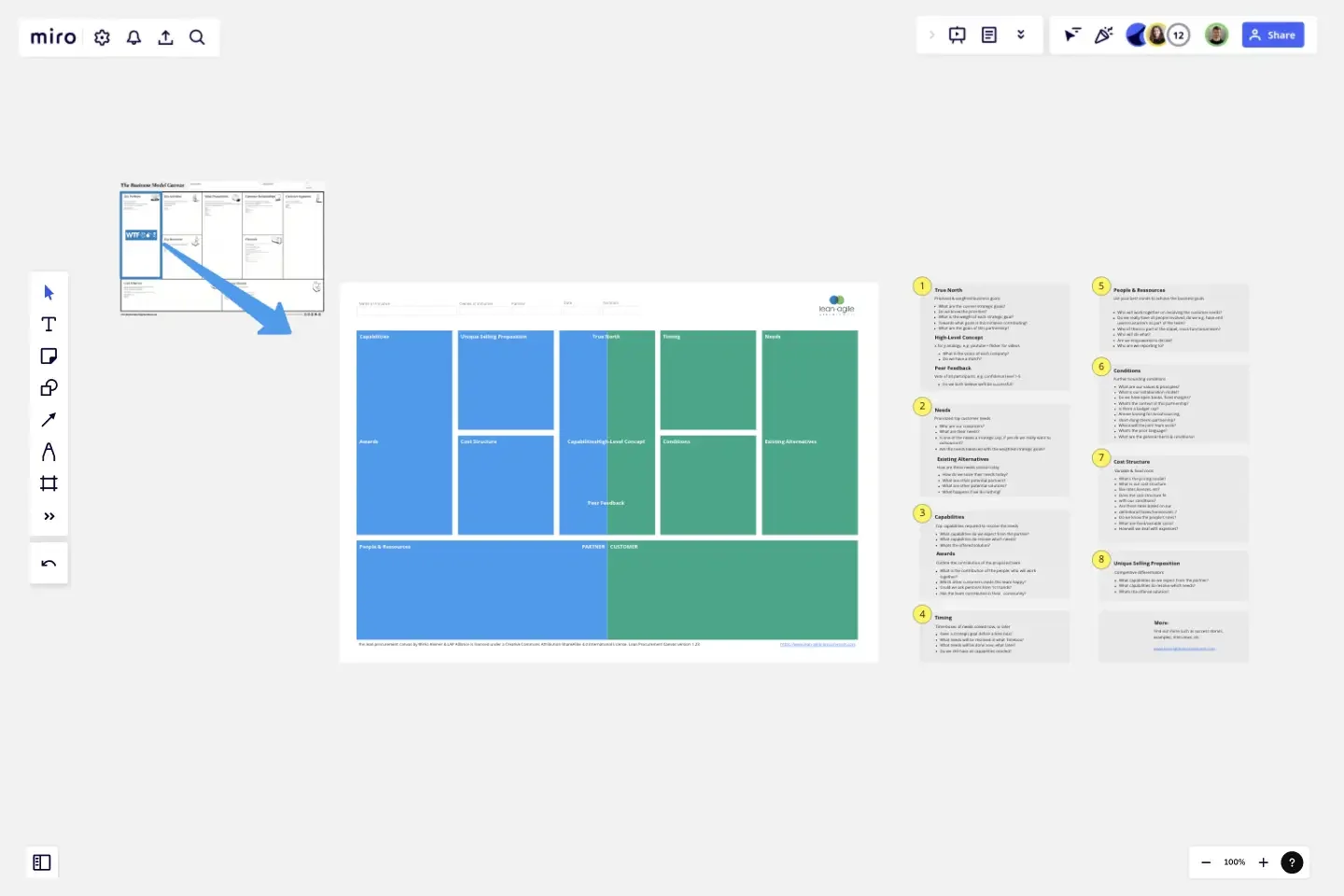Lean Procurement Canvas
With the Lean Procurement Canvas and Lean-Agile Procurement we provide for the very first time a tool and approach that respects agile values and practices during sourcing and/or sales.
For successfully going to market with a new business case, a strong team consisting of internal and/or external people is the foundation. However finding the right complementary people, partners, services or products isn’t easy and takes time. Current sourcing processes and approaches can’t cope with uncertainty and complexity of innovation, new strategic partners, etc.
When should you use the Lean Procurement Canvas?
With the Lean Procurement Canvas and Lean-Agile Procurement we provide for the very first time a tool and approach that respects agile values and practices during sourcing and/or sales. This leads to improved lead times of days/weeks instead of months (from idea to first value delivered), minimizes risk and maximizes business value!
Who is the Lean Procurement Canvas for?
The Canvas can be used by startups, corporations who would like to:
Setup and align a new internal, mixed or outsourced 3rd party agile product delivery team
Co-create an agile agreement with multiple vendors in the same room simultaneously
Assess and manage existing teams or partnerships with 3rd parties
Close a deal more effectively as a vendor
It has been used by Air France KLM, Gazprom, BNP Parisbas, Auckland Council and many more from the private and public sector.
Get started with this template right now.
PI Planning Template
Works best for:
PI Planning, Product Management
The Miro PI Planning Template streamlines the Program Increment planning process for Agile teams. It facilitates a collaborative environment, enabling teams to efficiently align on strategies, identify dependencies, and convert decisions into actionable tasks. With features like real-time collaboration, Jira integration, and a centralized workspace, the template supports teams in enhancing efficiency, engagement, and decision-making.
Feature Planning Template
Works best for:
Desk Research, Agile Methodology, Product Management
Features are what make a product or service fun, but adding new ones is no walk in the park. It takes many steps—ideating, designing, refining, building, testing, launching, and promoting—and just as many stakeholders. Feature Planning lets you put a smooth, sturdy process in place, so you can add a feature successfully, and spend less time and resources doing it. That makes our Feature Planning Template a smart starting point for anyone looking to add new product features, especially members of product, engineering, marketing, and sales teams.
Lean Canvas Template
Works best for:
Agile Methodology, Strategic Planning, Agile Workflows
Business opportunities can get dense, cumbersome, and complex, and evaluating them can be a real challenge. Let a lean canvas streamline things and break down your business idea for you and your team. A great tool or entrepreneurs and emerging businesses, this one-page business model gives you an easy, high-level view of your idea — so you can stay focused on overall strategy, identify potential threats and opportunities, and brainstorm the various factors at play in determining your potential profitability in an industry.
The Hot Air Balloon Retrospective
The Hot Air Balloon is a simple activity for helping the team identify things that makes them move faster, and things that slow them down.
What? So What? Now What? Template
Works best for:
Agile Workflows, Retrospectives, Brainstorming
The What? So What? Now What? Framework empowers you to uncover gaps in your understanding and learn from others’ perspectives. You can use the What? So What? Now What? Template to guide yourself or a group through a reflection exercise. Begin by thinking of a specific event or situation. During each phase, ask guiding questions to help participants reflect on their thoughts and experience. Working with your team, you can then utilize the template to record your ideas and to guide the experience.
Retrospective - Summer
Works best for:
Retrospectives, Agile Methodology, Meetings
The Retrospective - Summer template offers a seasonal and themed approach to retrospectives, perfect for capturing the spirit of summer. It provides elements for reflecting on achievements, experiences, and goals amidst the summer backdrop. This template enables teams to relax, recharge, and recalibrate their efforts for the upcoming season. By promoting reflection and rejuvenation, the Retrospective - Summer empowers teams to celebrate successes, learn from setbacks, and embark on new adventures with renewed energy and enthusiasm effectively.
